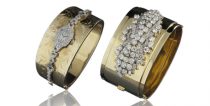Jewelry styles can be influenced by unusual events – and such was the case with convertible jewelry. While multi-use jewelry long preceded the Art Deco period, it was the Great Depression and some artful engineering that elevated convertible jewelry to new heights.
After the Stock Market crashed in 1929, jewelry became a luxury item for many women. Even high-end retailer Tiffany & Co. acknowledged the tenor of the times by running an ad that read: “Merchandise of Good Value and Fine Quality”.
The maison of Trabert & Hoeffer-Mauboussin saw opportunity amidst the challenges: it produced convertible jewelry for those on a budget. Remove a section from a necklace, for example, and it became a brooch.

This Art Deco brooch converts into two clips. A total of 19 carats of diamonds and two 3-carat emeralds glitter in the brooch. Photo by Robert Weldon/GIA, courtesy Kathryn Bonanno
“Convertible jewelry allowed women to purchase one piece and wear it in different ways on different evenings. The versatility was appealing and created the appearance of wealth,” says McKenzie Santimer, exhibit curator at GIA in Carlsbad.
A number of other prestigious jewelry houses also made convertible jewelry, which, frugality aside, had its own appeal. Cartier created a necklace that doubled as a diadem in 1929, and in 1937, a diamond and aquamarine tiara whose centerpiece became a clip. In the 1930s, Boucheron created clips that joined together to form a brooch, and necklaces that transformed into bracelets and diadems.
Van Cleef & Arpels’ Zip necklace/bracelet is probably the most famous piece of convertible jewelry. The Duchess of Windsor proposed the idea to Van Cleef & Arpels in the mid-to-late 1930s and their designers worked on it for years, delivering a functional piece in 1951. Designing and manufacturing a zipper from precious metal was a first – and an extraordinarily difficult feat that took craftspeople over a decade to perfect.

Van Cleef & Arpels made several ruby and diamond Zip bracelets that become necklaces (circa 1955). Two additional pieces (not shown separately) are added to the 7” bracelet to make the transformation into a necklace (they can be seen in the image on the right at 2:00 and 10:00). Photo © GIA and Tino Hammid, courtesy of a private collector
Steve Workman, instructor of Jewelry Design & Technology at GIA in Carlsbad, continues to marvel at convertible jewelry. “With its multipurpose invisible catches, convertible jewelry pieces were essentially sophisticated mechanical devices that had to be highly functional and secure. Making one required a master jeweler have an extraordinary level of skill and knowledge. It was truly a high-water mark in the history of the craft.”
Ready to see what some of the most creative jewelers devised? We’ve handpicked a few pieces below for your reading (and viewing) pleasure.
A sautoir (long necklace) with pendant by Trabert & Hoeffer-Mauboussin, circa 1935, turns into five pieces of jewelry: a brooch (which can be worn as a clip), two bracelets, and two clips. The engineering required to make this was extraordinarily sophisticated, and even more impressive considering that computer-aided design programs were decades away from being invented.
More treats in below piece: sapphires are carved into stylized flowers. Set between them are barrel shaped motifs accented with diamonds.

A sautoir (long necklace) with pendant by Trabert & Hoeffer-Mauboussin, circa 1935, turns into five pieces of jewelry. Photo © GIA and Tino Hammid, courtesy Neil Lane Jewelry, Beverly Hills
How many pieces of jewelry does the below pearl necklace become? Three brooches and the necklace make four. The necklace is comprised of individual strands of Keshi seed pearls (tiny pearls). Drilling holes and stringing them took infinite patience.

How many pieces of jewelry does this pearl necklace become? Three brooches and the necklace make four. Photo by Sylvia Bissonette, © J Grahl Design
Convertible jewelry had its hey-day during the Art Deco period. Time travel to this exciting period.
Main image by Robert Weldon/GIA, courtesy Kathryn Bonanno







